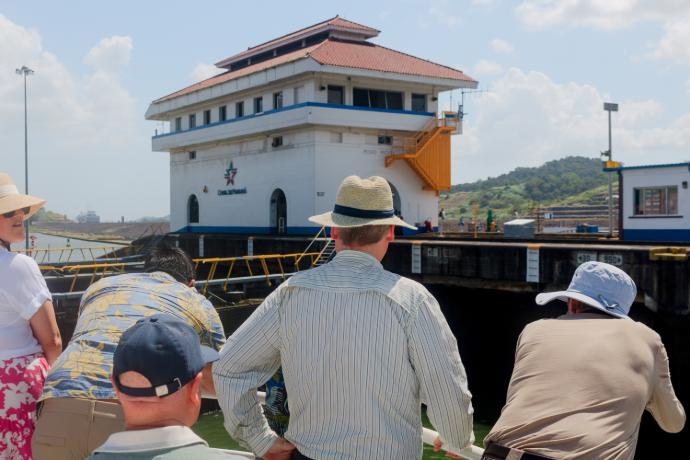The Panama Canal
Interesting facts about the Panama Canal

1 The Panama Canal is approximately 80 kilometers long between the Atlantic and Pacific Oceans. This waterway was cut through one of narrowest saddles of the isthmus that joins North and South America.
2 The Canal uses a system of locks -compartments with entrance and exit gates. The locks function as water lifts: they raise ships from sea level (the Pacific or the Atlantic) to the level of Gatun Lake (26 meters above sea level); ships then sail the channel through the Continental Divide.
3 Each set of locks bears the name of the townsite where it was built: Gatun (on the Atlantic side), and Pedro Miguel and Miraflores (on the Pacific side).
4 The lock chambers -steps-- are 33.53 meters wide by 304.8 meters long. The maximum dimensions of ships that can transit the Canal are: 32.3 meters in beam; draft -their depth reach- 12 meters in Tropical Fresh Water; and 294.1 meters long (depending on the type of ship).
5 The water used to raise and lower vessels in each set of locks comes from Gatun Lake by gravity; it comes into the locks through a system of main culverts that extend under the lock chambers from the sidewalls and the center wall.
6 The narrowest portion of the Canal is Culebra Cut, which extends from the north end of Pedro Miguel Locks to the south edge of Gatun Lake at Gamboa. This segment, approximately 13.7 kilometers long, is carved through the rock and shale of the Continental Divide.
7 Ships from all parts of the world transit daily through the Panama Canal. Some 13 to 14 thousand vessels use the Canal every year. The Panama Canal serves more than 144 maritime routes connecting 160 countries and reaching some 1,700 ports in the world.
8 The Canal has a work force of approximately 10 thousand employees and operates 24 hours a day, 365 days a year, providing transit service to vessels of all nations without discrimination.


Information provided from the ACP’s website (www.pancanal.com)
9 The Panama Canal Expansion was the largest infrastructure project since the Canal’s opening in 1914. Considered and analyzed for a decade with more than 100 studies, the Expanded Canal provides the world’s shippers, retailers, manufacturers and consumers with greater shipping options, better maritime service, enhanced logistics and supply-chain reliability.
10 Since its inauguration on June 26, 2017, the Expanded Canal increases the waterway's capacity to meet the growing demand of maritime trade using larger vessels, which means that the Panama route provides important economies of scale.
11 The Expansion included the construction of a new set of locks on the Atlantic and Pacific sides of the waterway, creating a third lane of traffic and doubling the cargo capacity of the waterway. It also included the creation of the Pacific Access Channel, improvement to the navigational channels, and improvements to the water supply.
12
While the lock chambers measure 427 meters long by 55 meters wide, and 18.3 meters deep, than those in the original Canal, they use less water due to water-savings basins that recycle 60 percent of the water used per transit. In line with its commitment to customer service, the Panama Canal will continue to provide the world with value for another century and beyond.